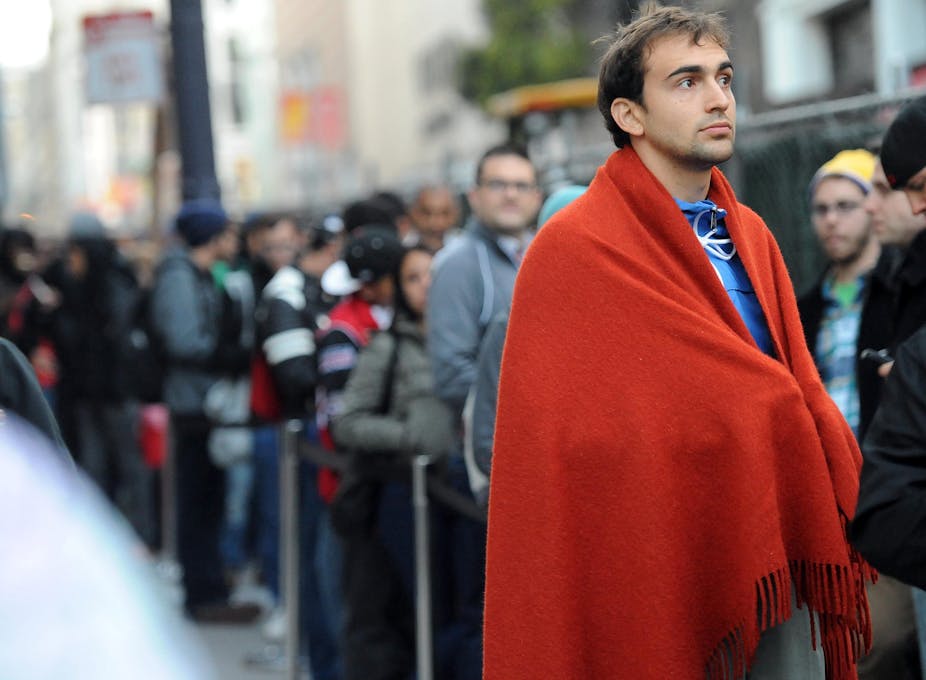Earlier today (AEST), Apple announced a range of new products, among them the iPad 4 (just six months after its predecessor) and the new baby in the family: the iPad mini.
Pre-orders begin later this week, and the iPad Mini will be available in stores from early next month. Will we see the usual hordes of people lining our streets and shopping centres, wallets bursting, frothing at the mouth for the latest entries to the Apple hagiography? I suspect we will.

As far as I’m aware, people never line up around the block to buy the latest-release washing machine or microwave oven. They don’t even do this for designer products such as the latest Dyson vacuum cleaner.
But we’re accustomed to newspaper shots of fanatical customers lining up for hours (or even days) to be the first to purchase techno-glories such as the iPhone 5 - despite the easier option of pre-orders or, controversially, waiting a day or two until the queues die down.
So why do Apple gizmos inspire such devotion?
Genesis
The love affair with Apple was perhaps enshrined through Ridley Scott’s now legendary “1984” commercial (see below), screened during the US Superbowl in the year of Apple’s launch.
As with his directorial triumph Blade Runner a couple of years earlier, Scott’s ad featured a possible dystopian future, but one that could be defeated through the liberating technology of Apple.
Apple silenced the Big Brother-like rhetoric, familiar to anyone with a passing knowledge of Orwell’s classic Nineteen Eighty-Four, claiming:
We have created, for the first time in all history, a garden of pure ideology – where each worker may bloom, secure from the pests purveying contradictory truths.
The release of the Apple Macintosh in 1984, by the late Steve Jobs, marked the birth of the graphical user interface – an interface allowing users to interact with their machines using images rather than text commands. But the computer itself didn’t become a sustainable proposition until desktop publishing emerged in 1985.
The disciples
In a 2011 BBC documentary, British neuroscientists suggested the brains of Apple followers are aroused by the company’s brand imagery, in a similar fashion to those of religious people who are stimulated by visual depictions from their faith.
These findings are an extension of similar work, published in 2001, with the provocative title, May the Force of the Operating System be With You: Macintosh Devotion as Implicit Religion.
Back in 2001 the Macintosh was already the technological object of desire for those in the design professions and allied niches, while the mass of end-users slogged away in the utilitarian Microsoft universe.
The “May the Force” study found people became devoted to Macintosh because of the positive bond they established with their computers. Furthermore, those who walked the Apple path were more prone to dream of utopian scenarios in which humans and technology co-existed in harmony.
The study’s lead researcher speculated that Macintosh buffs at the time shared traits with followers of both Eastern and Western religions, valuing personal spirituality while placing a premium on communal experience.
Decades of devotion
It wasn’t just the Macintosh that inspired a near-religious fervour among Apple devotees.
The Apple Newton (see above), a personal digital assistant, emerged in 1987 only to die out in 1998 and was, in many ways, a precursor to the iPhone.
The cultural fallout from the Newton’s demise was explored in a 2005 paper, Religiosity in the Abandoned Apple Newton Brand Community.
Drawing on a supposed link between religious motifs and a believer’s sense of freedom, the study explored the cult of the Apple Newton. The marginal status of the Newton – it was suggested – had fostered a community of people with a shared desire to champion and elevate the merits of an ignored brand.

The renaissance
Pundits – such as Virginia Postrel in her 2004 book The Substance of Style – often imply Apple’s renaissance is due more to a rediscovery of the aesthetic imperative in product manufacturing than any latent religious sentiment in consumers.
This makes sense, as design thinking has always been at the forefront of the Apple brand, as exemplified by Sir Jonathon Ive, the company’s senior vice-president of industrial design, who recently said the iPhone was nearly mothballed due to design concerns.
While Apple Inc. has its legion of die-hard supporters, there are always those with issues against this tallest of tall hi-tech poppies.
In his 2009 book The Future of the Internet - And How to Stop It Jonathan Zittrain argued that “tethered appliances” – ones that are closed off to amateur tweaking, and modifiable, to a large extent, only by their manufacturers – stifle the type of web-based innovation that made them possible in the first place.
Does that mean Apple gadgetry is destined to go the way of the pogo-stick and Tupperware party? Even suggesting this – at least for now – still feels like blasphemy.

